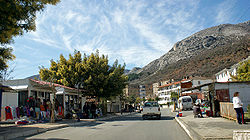Rubik, Albania
| Rubik | |
|---|---|
| Administrative Unit | |
 |
|
| Coordinates: 41°46′N 19°47′E / 41.767°N 19.783°ECoordinates: 41°46′N 19°47′E / 41.767°N 19.783°E | |
| Country |
|
| County | Lezhë |
| Municipality | Mirditë |
| • Administrative Unit | 140.5 km2 (54.2 sq mi) |
| Elevation | 77 m (253 ft) |
| Population (2011) | |
| • Administrative Unit | 4,454 |
| • Administrative Unit density | 32/km2 (82/sq mi) |
| Time zone | CET (UTC+1) |
| • Summer (DST) | CEST (UTC+2) |
| Postal Code | 4603 |
| Area Code | 0284 |
| Vehicle registration | MR |
| Website | http://www.bashkiarubik.al/ |
Rubik is a town and a former municipality located in the central-north of Albania along national roadway SH30 which links Tirana/Lezhë County with Rrëshen/Kukës and the new A1/SH5 Albania–Kosovo Highway. At the 2015 local government reform it became a subdivision of the municipality Mirditë. The population at the 2011 census was 4,454. The municipal unit consists of the town of Rubik at its center and eleven peripheral villages: Fang, Katund i Vjeter, Bulshizë, Rasfik, Fierzë, Munaz, Rreja e Velës, Livadhëza, Vau Shkjezë, Rrethi i Eperm, Bulgër, and Rreja e Zezë.
According to ancient Roman religion and Roman mythology, Robigo or Rubigo was the goddess that protected corn and other crops from diseases such as mildew and blight that infected crops, and in who's honor Robigalia festival was organized each April with people praying to her in order to remove rust from crops. Thus originates the name of Rubik. Early Illyrian inhabitants of the area performed rituals which were established by the Roman King Numa Pompilius, yearly on the 25th of April, when farmers would sacrifice a red goat, a red sheep, and offer wine to the goddess. In actuality, the "rust" was not from crops but from the soil of the area due to copper ore and acid waters of which often deadened plants to the very roots.
According to 2006 data, 2277 families or 8094 people reside in Rubik Municipality's jurisdiction. Of those 2277 families, about 1070 reside in the central town of Rubik which constitutes about 3736 people. The remaining 53% of the population, or 1207 families with 4358 people, inhabit the eleven villages within Rubik Municipality's administrative area.
Kishё e Shelbuemit ne Rubik or the Church of the Ascension in English, is the first building in Rubik that a traveler will notice as they drive along the Fan River. Towering over the small community of Rubik, the Franciscan monastery sits a top a white cliff as if observing the daily activities of the city. Originally established in 1166 as one of four Benedictine Conventions in the Mirdita region of present day Albania, the church represents the ascension of Jesus Christ following his 90-day return after Easter. The Benedictines of Rubik later delivered the Church to the Franciscan Order in Albania sometime around the year 1217 due to destruction of many lands and churches by Vandal Turkish Armies. Only five Franciscan conventions survived the Turkish raids of the time: that of Sebaste (Kurbin), Lezhe, Rubik, Mamli, and Bishti i Muzhlit (Durrës), which had more than 40 friars in total. The Franciscans who refused to accept the catastrophes the order had experienced established seven hospices (special housing for sheltering missionaries) the second of which was established in Rubik in the 16th century and was responsible for the populations of Fan, Kthelle, Selite, Lure, and Cidhen.
...
Wikipedia

